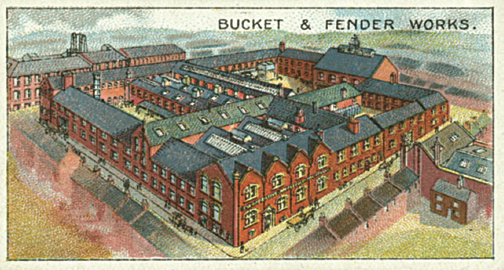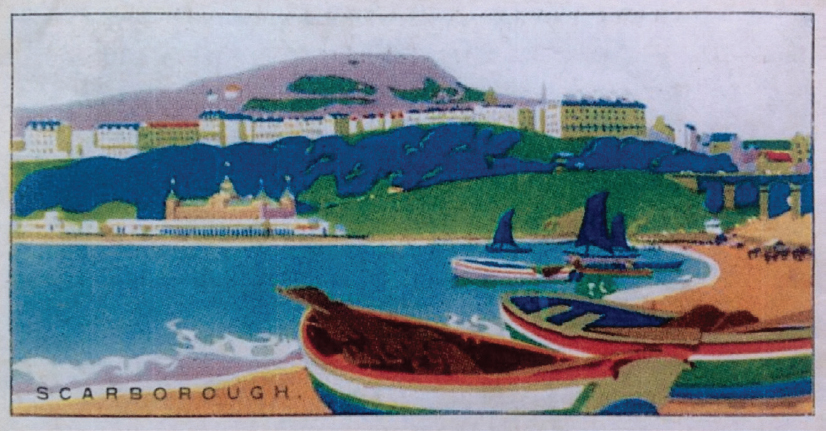
Great Britain and Ireland have rich landscapes, shaped over time by nature, farming, religion, invasion, merriment and utility. Card issuers have sought to bring their own interpretations of this scenery and, for those like this author who love nothing better than discovering the stories waiting to be discovered in every town and village and down every lane of this country, a collection devoted to places can bring the rich variety of the travel experience into the magic of a winter’s evening.
One popular theme for card issues was that of the holiday resort. F. & J. Smith’s Holiday Resorts, issued in 1926, evoke a bygone era of steam trains and endlessly sunny days by the seaside. Using contemporary railway posters for the illustrations, including the iconic ‘Skegness is so Bracing’ picture, this set of 25 cards has been reprinted to make their beauty more accessible for the collector. One particularly fine card is that showing Scarborough, from a London and North Eastern Railway poster originally by Frank Newbould:

The ‘Queen of Watering Places’ stands between the moors of Yorkshire and the sea. The position is magnificent, its two bays being divided by the lofty promontory on which stand the picturesque ruins of the historic castle, the Marine Drive round the base of the Castle Hill connecting the two bays with their splendid stretches of sand. Excellent bathing, boating and fishing may be obtained, and there are three golf courses. Scarborough’s fine Spa with its celebrated orchestra, promenade, concert hall, etc., is a unique attraction to the holiday maker.
This popularity of the British seaside holiday was reflected by other manufacturers. In 1937 Pattreiouex issued a set of 48 medium-sized cards of black and white photographs of Holiday Haunts by the Sea while Churchman’s Holidays in Britain of 1937 and 1938 is a set of 48 mediumsized cards featuring coloured scenes of a country on the eve of war. The first set contained a black and white photograph with a small map of the resort’s location. The latter set featured brightly coloured paintings of resorts such as Rye, Jersey, Falmouth, Tintagel, Ludlow, Abergavenny, Whitley Bay and Lerwick. The inclusion of many towns of interest gives the impression of the holiday as a cultural experience, as well as one seeking sun, sea and sand. Particularly impressive is the depiction of Dartmoor, with brooding clouds hanging over the moor. We are informed that:
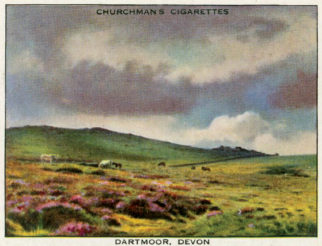
England’s most famous moor is a rambler’s paradise, but a good map and compass are essential. For it is practically a pathless waste, with many treacherous bogs, and there are only two main roads across it – Ashburton to Tavistock and Yelverton to Moretonhampstead. Mists are frequent, with a habit of coming on suddenly. The 130,000 acres were the home of a prehistoric people; hut settlements, stone circles and kistvacus remain to their memory. Dartmoor is a glorious expanse of rolling slopes and rugged tors, with occasional extremely pretty scenes of a gentler nature, such as at Dartmeet Bridge; it provides the happiest rambling ground in England.
Amalgamated Tobacco produced an attractive set of international Holiday Resorts in 1957, just at the time when foreign travel was becoming more popular with the British public due to cheaper air fares. A mint set of these 25 cards can be bought for a few pounds. They feature a wider variety of resorts than typical sets from two decades earlier, including Venice Ching’s issued 3 series of Jersey Past and Present cards in large format over 1960-1, showing the picturesque qualities of the island, which had been under Nazi occupation just fifteen years previously. Collectively, the 3 sets, running to 72 cards in all, can be had for a little over £20, a fine memento of a lovely place.
For those seeking their seascapes from a more dramatic angle, a number of sets featuring lighthouses are available. Societie Job issued a set of 25 Lighthouses in 1925, with attractive pale blues and whites as the predominant colours. In addition, the cards informed the owner of the technical features of each of the constructions. We learn that the Beachy Head Lighthouse in Sussex ‘thrusts its graceful lines direct from the water, its foundation being sunk in the Channel 550 feet from the base.’ The dramatically situated St. Catherine’s Point Lighthouse in the Isle of Wight has been a point of reference for sailors since at least the fourteenth century:
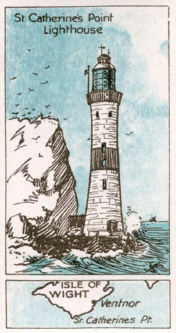
The Needles, situated at the western end of the Solent and St. Catherine’s, at the extreme southern point of the Isle of Wight. The present lighthouse was finished in 1840. An ancient light was first placed on St. Catherine’s Downs by the monks as far back as 131. One double occulting every 20 seconds (white, green and red arcs); visible 14 miles; 80 feet above high water.
The following year Wills issued an appealing set of 50 Lighthouses in Australia and New Zealand and more recently Ensign brought out a set of 6 large cards of Lighthouses in 2002 and Cardlynx a set of the same name and size in 2008. In addition, many individual lighthouses are featured in other sets.
One of the defining characteristics of the British landscape is its places of religious worship. Anyone who travels the country will see the familiar shape of a church tower or spire dominating the profile of most villages. This formed the idea of the Cathedrals and Churches series issued by Hignett in 1909. The depiction of these holy places is crisp and clear, as the example of the wonderful Norwich Cathedral demonstrates The accompanying text informs us that:

The Cathedral Church of the Holy Trinity, Norwich, stands today, in its plan and in most of its detail, practically as it was completed (about 1200). It is unequalled for its magnificence, for the vaulting of the roof, and for the flying-buttresses at the east end; while the nave is one of the longest in England (259 feet). The handsome Norman tower and spire were built about 1470. In 1643 Norwich Cathedral suffered great destruction at the hands of the Parliamentarians.
The careful buyer can purchase a very good set of 25 cards for just over £20. Churchman’s Cathedrals and Churches demonstrated the firm’s interest in the country’s religious landscape. The same Ipswich-based company issued two further locally-focussed Christian sets: East Suffolk Churches and West Suffolk Churches.
Many card companies issued sets of scenes associated with the area in which they were based. Gallaher of Belfast put out around 600 cards of Irish Views Scenery. Lambert and Butler featured The Thames from Lechlade to London, while A.&J. Couden’s Holiday Resorts of East Anglia and Churchman’s Rivers and Broads of Norfolk and Suffolk celebrated the attractions of the eastern part of the country. E.& W. Anstie of Devizes issued a series of sectional cards featuring, in turn, Stonehenge, Wells Cathedral and the Wiltshire Downs. Pascall issued sets based on Devon. Those interested in landscapes beyond the UK are well catered for in sets such as Edwards, Ringer and Bigg’s Alpine Views, Wills’ Transvaal Series and Rothman’s New Zealand.
Player was a significant issuer of cards showing aspects of the built environment, such as Celebrated Gateways, Picturesque Bridges and Picturesque Cottages. In 1936 Ogden issued a set of Picturesque Villages. It could be argued that the selection is rather arbitrary, with 4 cards set in Wiltshire; Dorset, Gloucestershire and Yorkshire being featured on 3 cards each; while Sussex and Lincolnshire have none. An overview of the full set would suggest English village life of the 1930s was one of vernacular cottages, churches, village greens and virtually no traffic.
As the twenty-first century progresses, many of our traditional British pubs are closing. Therefore R. Lloyd & Sons’ Old English Inns reminds us of a time when these places were important stopping off points on major routes across the country, as well-known as the motorway service stations of today but with somewhat more charm and character. The set includes the Royal Anchor at Liphook, a familiar stopping-off point for Lord Nelson on the way to Portsmouth.
Hignett’s series of 50 Celebrated Old Inns of 1925 would make an excellent basis for a countrywide road trip. The company chose locations of both architectural beauty and historical significance. The Clough’s Inn in Chard, Somerset was reputed to be the place were Lord Chief Justice Jeffreys stayed in 1685 while carrying out the Bloody Assizes, sentencing hundreds of rebels following the Monmouth Rebellion of 1685. Many of the historic inns featured have since ceased to exist as places of refreshment and fellowship. For example, the Red Horse in Stratford is now a branch of Marks and Spencer’s and the Great White Horse in Ipswich now offers liquid refreshment of a different kind as a Starbucks. One establishment that still welcomes visitors as a pub is the Saracens Head in the picturesque Nottinghamshire town of Southwell. Now a thriving wedding venue, restaurant and hotel, the reverse of the card informs us that:
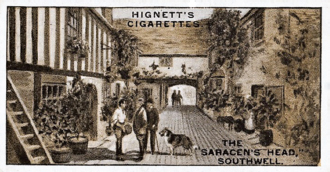
This ancient and historic hostelry has many interesting memories. Both Edward I and Edward III are said to have lodged here; but it was intimately connected with the fortunes of Charles I who frequently during the Civil War stayed at the ‘Saracen’s Head’, then known as the ‘King’s Arms.! Here he rested on his way to raise the Royal Standard at Nottingham in 1642, and here, four years later, he surrendered himself to the Scottish Commissioners. The bedroom he occupied and the four-poster bed upon which he slept are still to be seen.
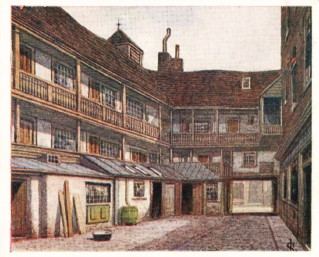
One outstanding set, which features many inns alongside other buildings of note, is Hill and Archer’s Historic Places from Dickens Classics. Included in this set is the courtyard of the White Hart Inn, Borough, London, where Samuel Weller first met Mr Pickwick. There are also the buildings used by Dickens as The Old Curiosity Shop and Miss Havisham’s House. This set of large cards can retail for around £40.
London has many sets devoted to its urban landscape, such as Carreras’ Views of London, Hignett’s Historical London, while Wills looked further afield for its magnificent Cities of Britain series of 1929. This was an unusually large set of postcard-sized cards and ran to just 12 different examples. Those cities selected for inclusion were the large industrial centres of the United Kingdom: Birmingham, Bristol, Cardiff, Glasgow, Edinburgh, London, Liverpool, Leeds, Sheffield and Manchester. In addition, the two smaller cathedral and minster cities of Chester and York are featured. The front of each card gives the coat of arms of each city, and 5 colourful views of landscape, important buildings, and industry and commerce. The reverse of the card has enough space to comment on the city’s statistics, history, architecture and industries. York’s card demonstrates the ancient city’s diversity: the Roman Walls, chocolate manufacturing, railway engineering and the medieval Shambles. Liverpool’s includes the then unfinished Anglican Cathedral, begun by Bishop Francis Chavasse, the father of double VC hero Noel Chavasse, and for Sheffield and Manchester we see manufacture of cutlery and cotton respectively. Appropriately, one of the representations of Bristol shows the W.D. & H.O. Wills tobacco factory. When this unusual set is offered for sale, it often realises around £100.
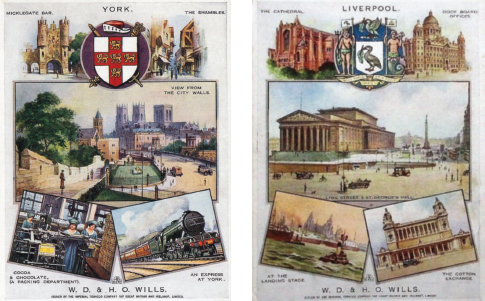
Pattreiouex had a number of issues featuring places in Britain, Real Photographs of London (1935), Sights of London (1935), Bridges of Britain (1938) and Britain from the Air (1939). This whole series is a valuable photographic record of Britain in the 1930s, before the Luftwaffe destroyed much of the fabric of our towns and cities, to be followed up by ‘progressive’ housing and city centre developments which rendered the character of much of the country unrecognisable from that which existed in pre-war Britain. Of particular historical significance is the Britain from the Air set, as it included photographs of well-known landmarks such as Buckingham Palace. It has been claimed that Herman Goering, Chief of the Luftwaffe, had his pilots study them before launching the blitz on Britain in 1940. Certainly, issuing sets of high-quality photographs of important sites on cigarette cards, at a time when they had been banned in Germany, was of questionable judgement.
Although there is much to enjoy about the British landscape, it should not be overlooked that many sites throughout the country have seen hundreds of thousands of people meet a bloody end in battles fought over the monarchy. F. & J. Smith’s Battlefields of Britain, issued in 1913, is a set of 50 marvellously informative cards which take us from the Battle of Ashdown of 871 where the future King Alfred the Great, then just a prince of 22, led his brother’s army to victory against the invading Danes, through the centuries up to the Battle of Culloden in 1746, the last of many battles which has disfigured the relationship between Scotland and England down the years. The collection covers the great events of 1066, which saw the Saxon House of Wessex overthrown by Norman invasion, the wars against the Scots and French throughout the medieval period, and many of the battles which took place between the Houses of Lancaster and York during what was later called ‘The Wars of the Roses’.
These include the Battle of Towton of 1461, for which contemporary reports cited the loss of 28,000 lives, one of, if not the, bloodiest day in British history. The victory of Edward, Duke of York, ensured his sovereignty as Edward IV and avenged the death of his father, Richard, Duke of York, at the Battle of Wakefield just three months earlier. Another card features this battle and tells us:
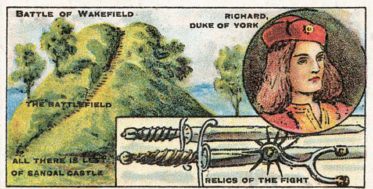
Fought Dec 30th 1460, between the Lancastrians under Somerset, and Yorkists under Richard Duke of York. The Lancastrians advanced from Pontefract. Somerset prepared an ambush, into which the Duke fell as he marched out of Wakefield, and the Yorkists were defeated. The Duke was killed and Salisbury captured and beheaded.
Each card shows a picture of one or two of the main protagonists and from this card we learn that ‘All There is Left of Sandal Castle’ is a mound with some steps. Fortunately excavations in the 1960s and 70s have revealed much more of this historic site, from where a potential king of England marched out to meet his end less than a mile away.
The set also takes us through the great battles of the English Civil War such as Edgehill (1642), Marston Moor (1644) and Naseby (1645), and those of the later seventeenth century and mid-eighteenth century as the Catholic James Stuart and his descendants were ousted from power and sought to reclaim the throne. A full set of this issue would cost over £700, with odds frequently sold for £10- £15 depending on scarcity and condition.
Further evidence of Britain’s military history can be found in its network of castles. In 1925 Wills brought out British Castles, a stunning set of 25 medium-sized cards featuring the most dramatic examples of these fortresses. Few would argue that one of the most awe-inspiring views in the country is that of Corfe Castle in Dorset. The larger format of this series enabled a good amount of detail to be included for the education of the collector. We are left in little doubt of the historical sympathies of the copywriter:
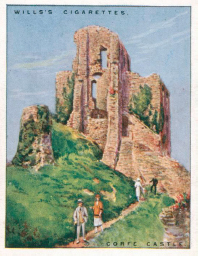
One of the most striking of ruined fortresses is Corfe Castle, on its great chalk hill in the Isle of Purbeck, Dorsetshire. It commands the whole range of the Purbeck Hills, and on this site, famous in those days as Corfe Gate, the Saxon King Edgar built his fortified palace. This castle was left to his widow Elfrida, and soon afterwards became the scene of the murder of her step-son, Edward ‘the Martyr,’ by her command. In 1139 the Norman castle was besieged by King Stephen, and in later years it was associated with King John, King Edward II, and other personages. During the Civil War, Corfe Castle was gallantly held against the Commonwealth forces by Lady Bankes, and in 1646 the Parliament issued an order to ‘slight,’ i.e. dismantle the fortress, a decree which was carried out with unnecessary thoroughness.
A set similar in design and impressiveness to the British Castles series was Wills’ Beautiful Homes series of 1930. Featuring 25 fine properties, we are reminded of the former grandeur of Clumber Park. Today tens of thousands of people enjoy the vast Nottinghamshire estate now in the care of the National Trust. However, where the large house which once belonged to the Dukes of Newcastle stood, there is now just the footprint of a building. A succession of fires which damaged some of the fabric, and the effects of the First World War and the Great Depression, meant that the property was demolished in 1938, just eight years after its celebration in this fine set. We learn that:
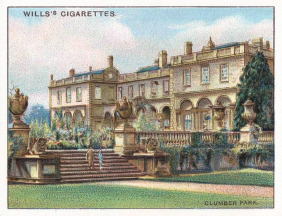
The finest portion of what now remains of the famous Sherwood Forest is the district known as the ‘Dukeries,’ much of which belongs to the Duke of Newcastle, whose seat, Clumber Park, is about 4 miles from Worksop. This great house was built by the 2nd Duke of Newcastle towards the end of the 18th century, the architect being Stephen Wright, Deputy Surveyor of the Board of Works. The interior of Clumber is noteworthy for the very fine collection of 18th century French furniture it contains. In 1879 a fire destroyed some of the older portions of the house, and in 1880 the work of rebuilding commenced under the architect Charles Barry. The magnificent Italian gardens are an appropriate setting for the stately magnificence of Clumber.
A celebration of Britain’s status as an imperial power was a frequent theme of place-based trade cards. One early example was Player’s issue of an extremely attractive set of 50 British Empire Series cards in 1904, which now cost up to £100 for a very good example. The brightly coloured paintings take us from the Ice Boats on the St Lawrence, through to Gold Washing in British Columbia and Tiger Hunting in Bengal; from a Zulu Carriage to Wheat Threshing in Malta. The virtues of the British Empire are displayed on card number 44 depicting an attractive street scene in Singapore. The card is titled Mohamedan Mosque & Chinese Temple, Singapore, and informs us in self-confident and self-congratulatory terms that:
Throughout the British Empire the right to worship as they please is granted to members of every religion and every sect. Here in Singapore, the Mahomedan Mosque is faced by the Chinese Temple, and the two sects live together in peaceful proximity.
Shortly afterwards came Cadbury’s British Colonies, Maps & Industries of 1912, a set of 6 cards featuring Canada, Australia, Jamaica, Trinidad and another issue which demonstrated the reach of British power. This range of British influence throughout the world was the theme of Pattreiouex’s series of the British Empire Exhibition cards, celebrating the Wembley-based attraction which was open through 1924-5, designed to reassert British self-esteem as other nations sought to oust the United Kingdom from its prominent place in the world. Included are cards depicting Canada, New Zealand, Palestine, Burma, Ceylon, Australia, India, Tibet, Newfoundland, Bermuda, Cyprus, Sierra Leone, Malaya, Gold Coast, Nigeria and Fiji. There is a card of the model lake, on which trips could be taken on motor-boats manned by bluejackets, ‘while those who are more energetically inclined may indulge in rowing.’ The card of the Palace of Industry shows ‘exhibits of Jewellery, Textiles, Pottery, Glass, Boots and Biscuits’. Britain’s preeminent trading position was demonstrated in the HM Government building which had a relief map of the world with ‘model sailing ships sailing over the main trade routes that connect the different parts of the British Empire’. All the roads emanating from the Central Avenue of the exhibition were ‘very appropriately named by Mr Rudyard Kipling, the poet of Empire’. The exhibition featured a coal mine, appropriately as that mineral was the basis of much of Britain’s wealth, and the Old London Bridge. Card number 13 informs us that:
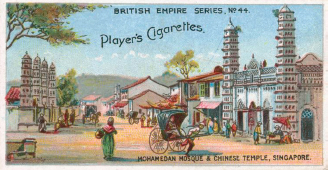
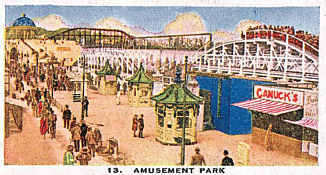
The Amusement Park had been laid out by a master of scenic effect. Amongst the many shows are the Giant Switchback – over a mile long – Racing Coasters, the ‘Glyda,’ the Whirl of the World, and Aquarium, a Colliery, the Tomb of Tutankhamen and very many other attractions. The Amusement Park is certainly not a place to be missed by visitors.
Of particular charm and evocativeness is the set issued by Ogden in 1932 entitled By the Roadside. The 50 cards are a panoply of sites of historic and cultural interest spanning millennia of English history, which were becoming increasingly accessible for the middle-class family who owned a car. They feature an inlay of a map showing the site’s geographical location and a coloured painting of the attraction. Included are ancient marketplaces such as the Yarn Market in Dunster, the Butter Market in Dartmouth and the Market Cross and Stocks at Bottesford, Leicestershire. There are churches, castles, bridges timber-framed houses, windmills a smithy and a Beheading Stone in Stirling.
Card number 27 featured the ancient Iron Age hill fort of Maiden Castle in Dorset. In this scene, a handful of sheep graze contemplatively by the enormous earthworks which have dominated the South Dorset landscape for millennia. We learn that:

On this hill are some of the most important pre-Roman remains in Britain. The name is derived from Mai-Dun meaning ‘Hill of Strength.’ This ancient fortress covers an area of over 110 acres, and some of the ramparts are 60 feet high. The tribe of the Durotriges occupied this primitive fortress, which is a remarkable example of the skill and industry of the ancient Britons. The Romans probably used this fortress while building their Durnovaria, which is known to us as Dorchester.
Pattreiouex issued 3 sets of 48 medium-sized cards titled Sights of Britain in 1936-7 which can be bought for £15-25 per set. The content of the black and white photograph cards ranges from the remote and isolated Kirkstone Pass in the Lake District to the bustle of the port of Polperro in Cornwall. The same company produced Bridges of Britain in a similar format in 1938, showing a range of beautiful structures from ancient packhorse bridges through to the Forth Railway Bridge. Sodastream issued a Historical Buildings set in 1957 while Barratt’s issued sets of the same name in 1960 and 1964. More recently Fax Pax issued a set of 40 large cards of Historic Houses in 1988.
Sarony’s A Day on the Airway, of 1928, a set of 25 large cards, takes us on a colourful fictitious flight from Croydon Airport, through checkout and departure and over Calais, Ypres, Brussels, Bruges, Ostend, Zeebrugge, Rotterdam, and The Hague, finishing in Amsterdam. The description of the Belgian town of Ypres, which had become so horrifically familiar to hundreds of thousands of British troops just a decade previously, demonstrated both the scars that the war had left, and the determination of the Belgian people to repair the landscape:
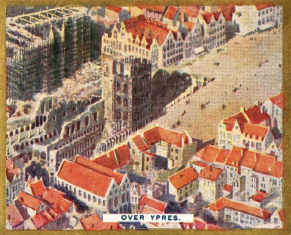
A gradual turn inland and the air express is passing over a never-to-be-forgotten war area. Away to the right is Poperinghe, dear to the heart of every ‘Tommy’, while more directly on the line of flight is Dixmude, and a no-man’s land of the war. Soon we are looking down on the Yser canal and to either side British and German block-houses are pointed out. Seemingly coming towards us is Ypres and in a matter of minutes we are over the area associated so imperishably with the British forces. Below us, replacing the grim devastations of war, list a panorama of fresh-tiled buildings – an amazing spectacle to every man with memories of ‘The Salient’. Clearly we can discern the Grand Place and the reconstruction of the famous 13th century Cloth Hall with its splendid belfry; also the rebuilt 13th century Cathedral of St. Martin. Both had been battered to ruin by the German bombardments.
There is insufficient space to touch on the range of places across the world included on cigarette and trade cards. Anyone wishing to develop a collection along these lines will find a huge variety of beautifully illustrated cards to choose from.
Nevertheless, it is evident that the collector can build up a substantial library of information on the grand, the picturesque, the historical, the sublime and the relaxing landscape. But it is not just famous or worthy places which feature on trade cards. This chapter will finish with one unusually niche set of cards which was issued by the Co-operative Wholesale Society in 1916 and featured Co-operative Buildings and Works. It included a birdseye view of the Bacon Factory at Tralee, the façade of the London Tea Department, the Hosiery Factory at Huthwaite and the Bucket and Fender Works at Dudley which manufactured ‘fenders, fireirons (curb, brass and antique) and fire brasses. While British people of the twentieth century often sought out the beauty of what was increasingly available by motor transport, many of their daily lives were defined by such places as these, and it is only fitting that they should be recorded for posterity.
